New Testament Apocrypha - Lesson 2
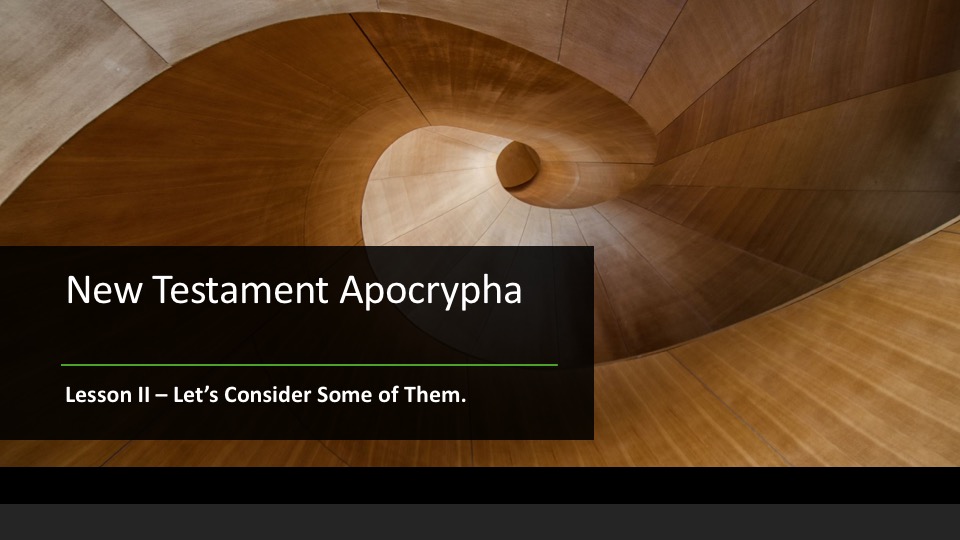
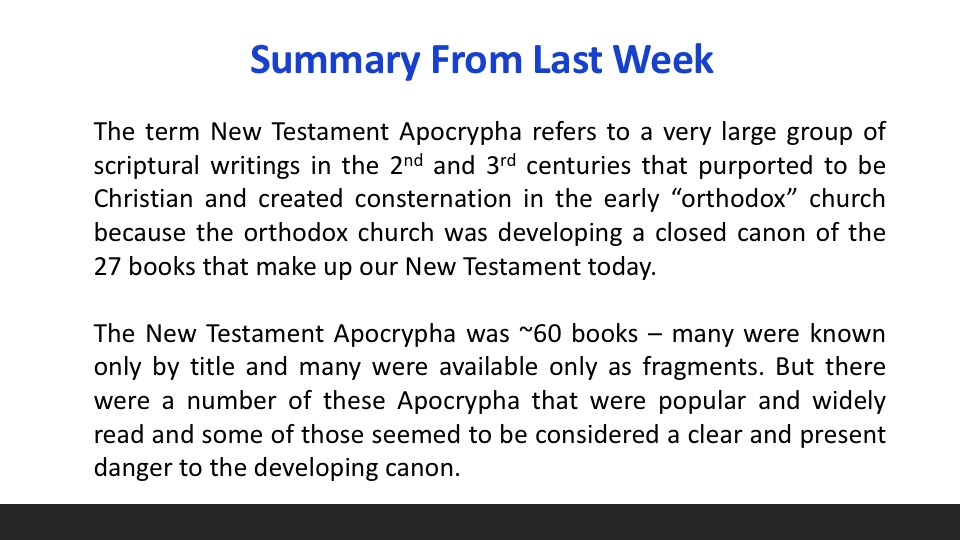
Summary From Last Week
The term New Testament Apocrypha refers to a very large group of scriptural writings in the 2ndand 3rd centuries that purported to be Christian and created consternation in the early “orthodox” church because the orthodox church was developing a closed canon of the 27 books that make up our New Testament today.
The New Testament Apocrypha was ~60 books – many were known only by title and many were available only as fragments. But there were a number of these Apocrypha that were popular and widely read and some of those seemed to be considered a clear and present danger to the developing canon.
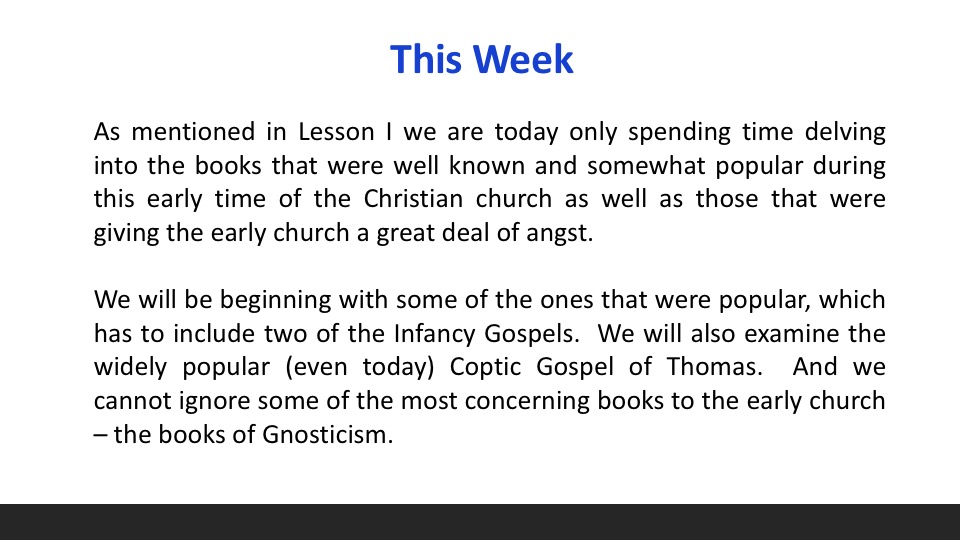
This Week
As mentioned in Lesson I we are today only spending time delving into the books that were well known and somewhat popular during this early time of the Christian church as well as those that were giving the early church a great deal of angst.
We will be beginning with some of the ones that were popular, which has to include two of the Infancy Gospels. We will also examine the widely popular (even today) Coptic Gospel of Thomas. And we cannot ignore some of the most concerning books to the early church – the books of Gnosticism.
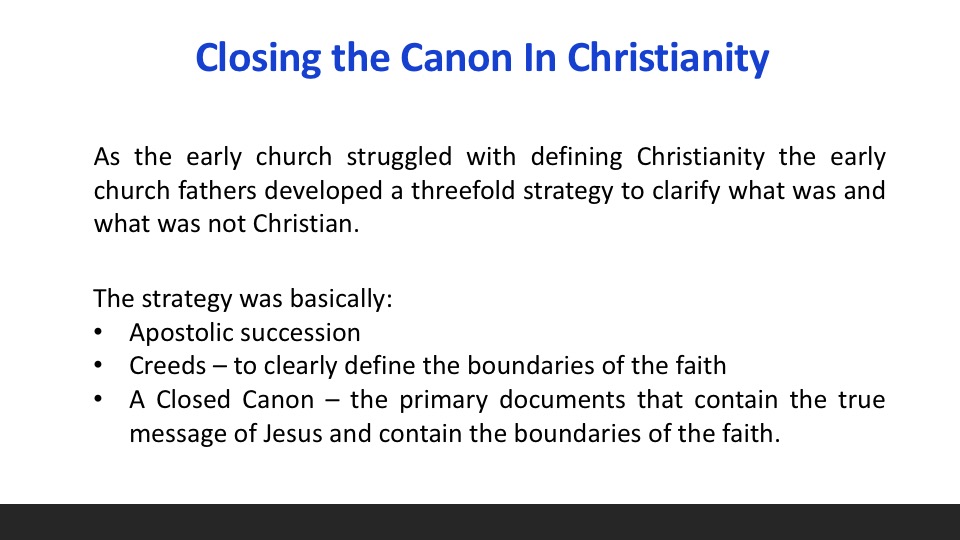
Closing the Canon In Christianity
As the early church struggled with defining Christianity the early church fathers developed a threefold strategy to clarify what was and what was not Christian.
The strategy was basically:
• Apostolic succession
• Creeds – to clearly define the boundaries of the faith
• A Closed Canon – the primary documents that contain the true message of Jesus and contain the boundaries of the faith.
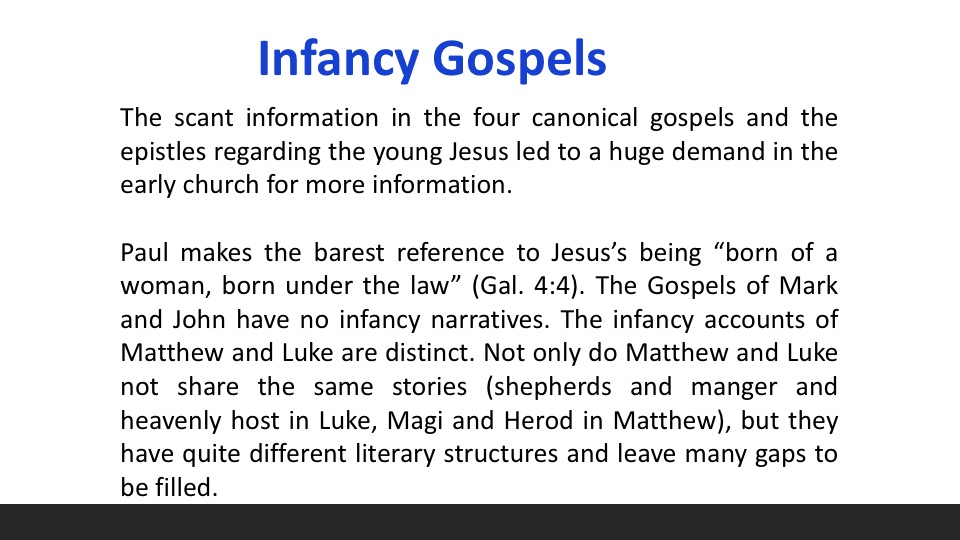
Infancy Gospels
The scant information in the four canonical gospels and the epistles regarding the young Jesus led to a huge demand in the early church for more information.
Paul makes the barest reference to Jesus’s being “born of a woman, born under the law” (Gal. 4:4). The Gospels of Mark and John have no infancy narratives. Apart from (quite different) genealogies and shared names, the infancy accounts of Matthew and Luke are distinct. Not only do Matthew and Luke not share the same stories (shepherds and manger and heavenly host in Luke, Magi, Herod and flight to Egypt in Matthew), but they have quite different literary structures and leave many gaps to be filled.
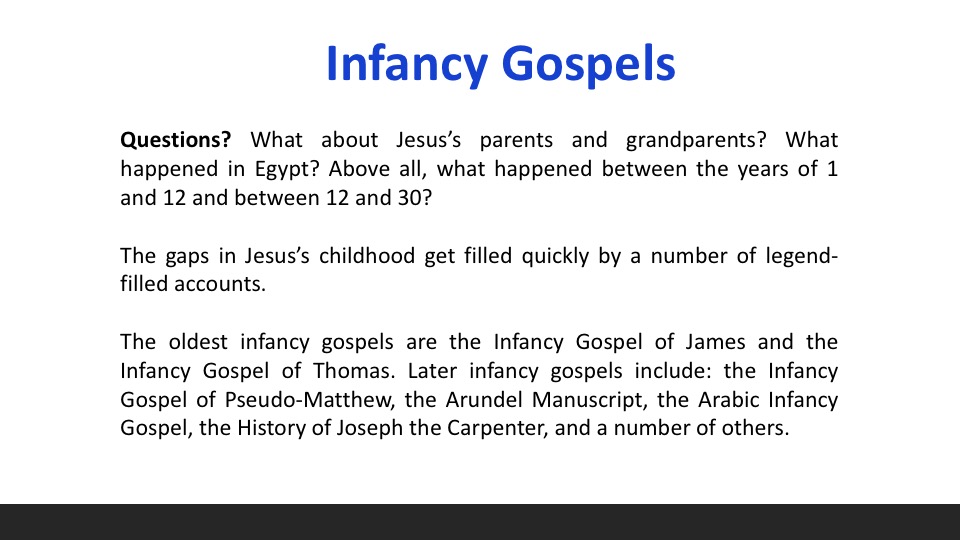
Infancy Gospels
Questions: What about Jesus’s parents and grandparents? What happened in Egypt? Above all, what happened between the years of 1 and 12 and between 12 and 30? The gaps in Jesus’s childhood are filled by a number of legend-filled accounts. The oldest infancy gospels are the Infancy Gospel of James (ProtevangeliumJacobi), and the Infancy Gospel of Thomas. Later infancy gospels include: the Infancy Gospel of Pseudo-Matthew, the Arundel Manuscript, the Arabic Infancy Gospel, the History of Joseph the Carpenter, and a number of others.
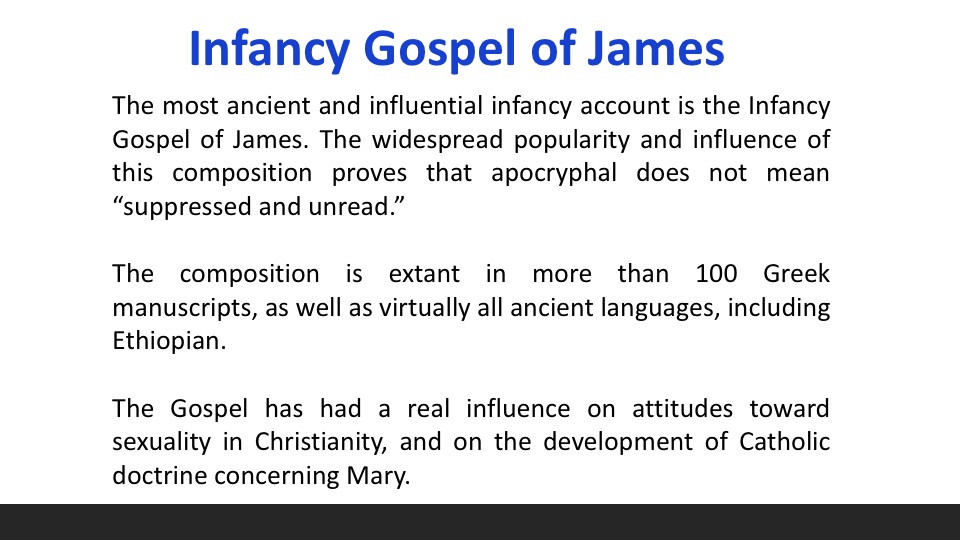
Infancy Gospel of James
The most ancient and influential infancy account is the Infancy Gospel of James. The widespread popularity and influence of this composition proves that apocryphal does not mean “suppressed and unread.” The composition is extant in more than 100 Greek manuscripts, as well as virtually all ancient languages, including Ethiopian. Its absence in Latin probably is due to the hostility of Jerome and the development of Latin infancy Gospels, such as Pseudo-Matthew. The Gospel has had a real influence on attitudes toward sexuality in Christianity, on the development of doctrine concerning Mary, and on the artistic conventions of the West (see the age and the flowering rod of Joseph).
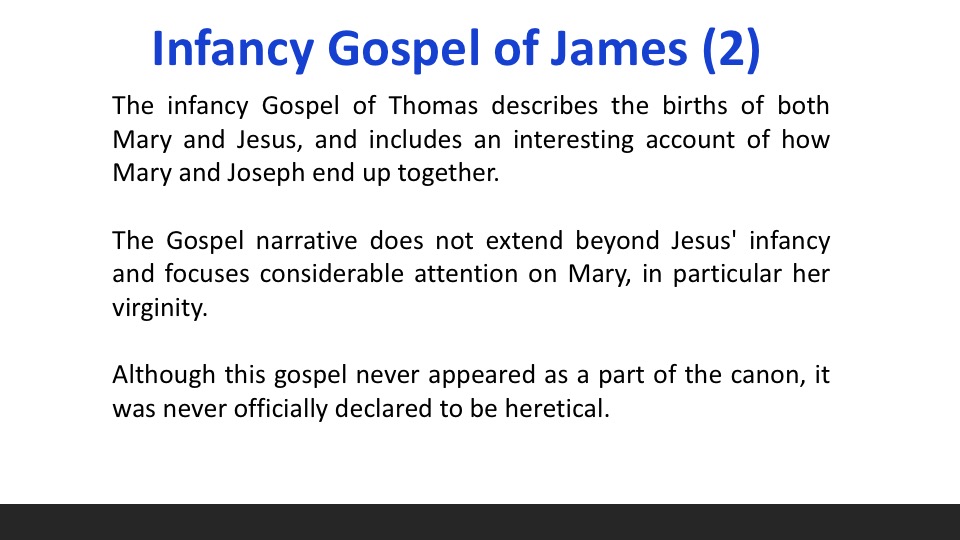
Infancy Gospel of James (2)
The infancy Gospel of Thomas gives an account of the births of both Mary and Jesus, and includes an interesting account of how Mary and Joseph end up together. The Gospel narrative does not extend beyond Jesus' infancy and focuses considerable attention on Mary, in particular her virginity. Although this gospel never appeared as a part of the canon, it was never officially declared to be heretical.
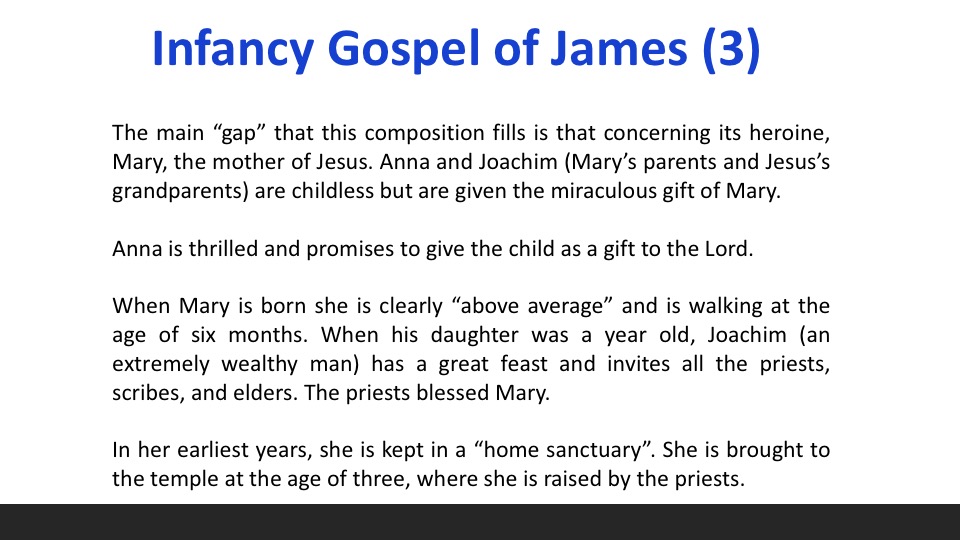
Infancy Gospel of James (3)
The main “gap” that this composition fills is that concerning its hero, Mary, the mother of Jesus. Anna and Joachim (Mary’s parents and Jesus’s grandparents) are childless but are given the miraculous gift of Mary.
Anna is thrilled and promises to give the child as a gift to the Lord.
When Mary is born she is clearly “above average” and is walking at the age of six months. When his daughter was a year old, Joachim (an extremely wealthy man) has a great feast and invites all the priests, scribes, and elders. The priests blessed Mary.
In her earliest years, she is kept in a “home sanctuary”. She is brought to the temple at the age of three, where she is raised by the priests. She is raised in a state of cultic purity in the temple in Jerusalem.
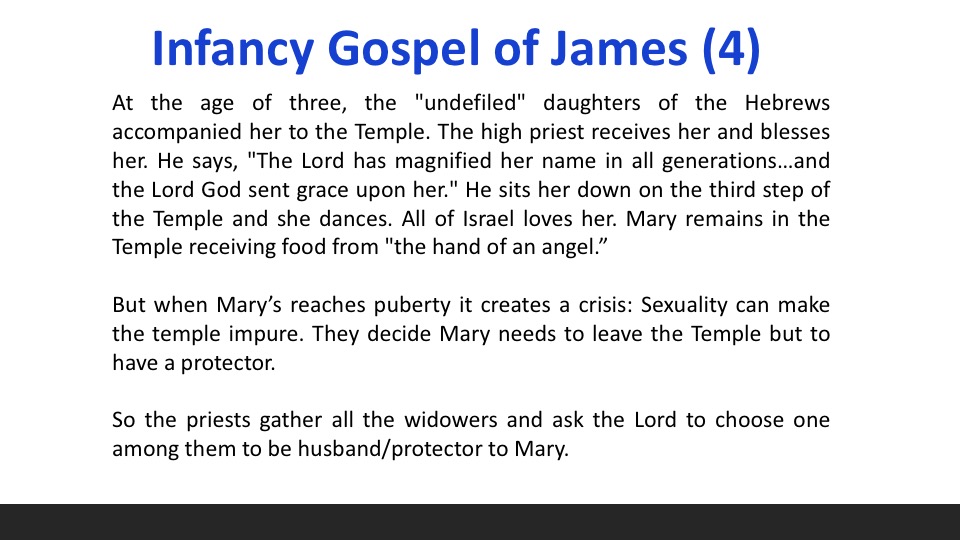
Infancy Gospel of James (4)
At the age of three, the "undefiled" daughters of the Hebrews accompanied her to the Temple. The high priest receives her and blesses her. He says, "The Lord has magnified her name in all generations…and the Lord God sent grace upon her." He sits her down on the third step of the Temple and she dances. All of Israel loves her. Mary remains in the Temple receiving food from "the hand of an angel."
But when Mary’s reaches puberty it creates a crisis: Sexuality can make the temple impure. They decide Mary needs to leave the Temple but to have a protector.
So the priests gather all the widowers and ask the Lord to choose one among them to be husband/protector to Mary.
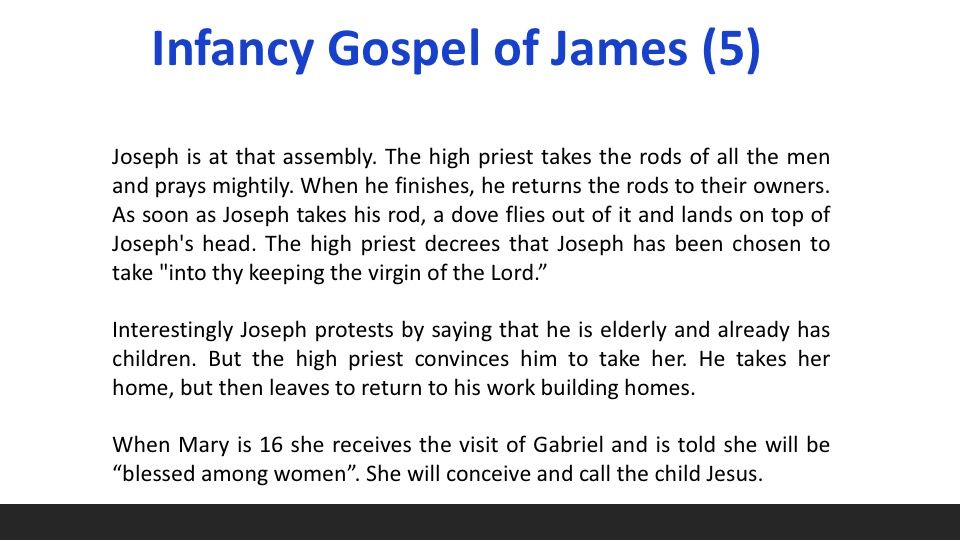
Infancy Gospel of James (5)
Joseph is at that assembly. The high priest takes the rods of all the men and prays mightily. When he finishes, he returns the rods to their owners. As soon as Joseph takes his rod, a dove flies out of it and lands on top of Joseph's head. The high priest decrees that Joseph has been chosen to take "into thy keeping the virgin of the Lord."
Interestingly Joseph protests by saying that he is elderly and already has children. But the priest convinces him to take her.He takes her home, but then leaves to return to his work building homes.
When Mary is 16 she receives the visit of Gabriel and is told she will be “blessed among women”. She will conceive and call the child Jesus.
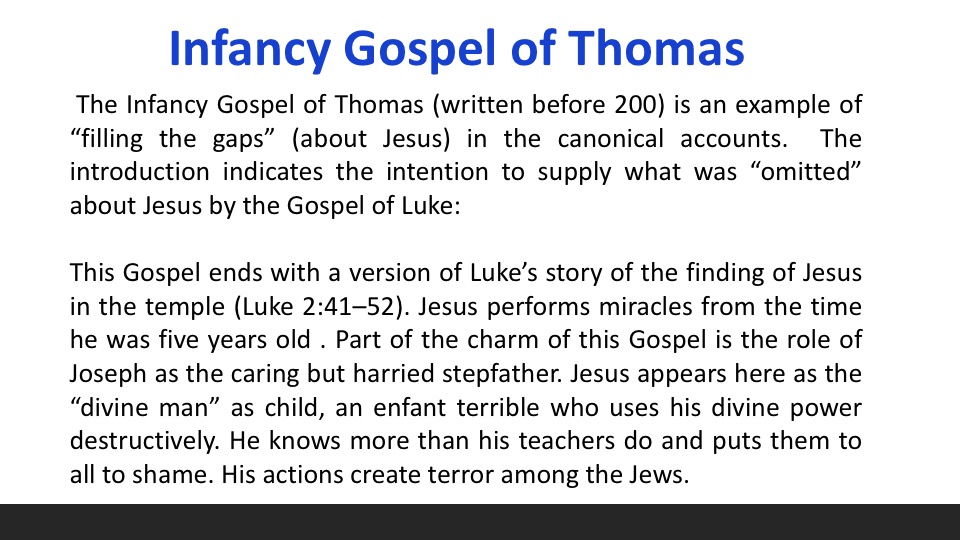
Infancy Gospel of Thomas
The Infancy Gospel of Thomas (written before 200) is a remarkable example of “filling the gaps” (about Jesus) in the canonical accounts.
The introduction indicates the intention to supply what was “omitted” by the Gospel of Luke:
This Gospel ends with a version of Luke’s story of the finding of Jesus in the temple (Luke 2:41–52). Jesus performs miracles from the time he was five years old . Part of the charm of this Gospel is the role of Joseph as the caring but harried stepfather. Jesus appears here as the “divine man” as child, an enfant terrible who uses his divine power destructively. He knows more than his teachers do and puts them to all to shame. His actions create terror among the Jews.
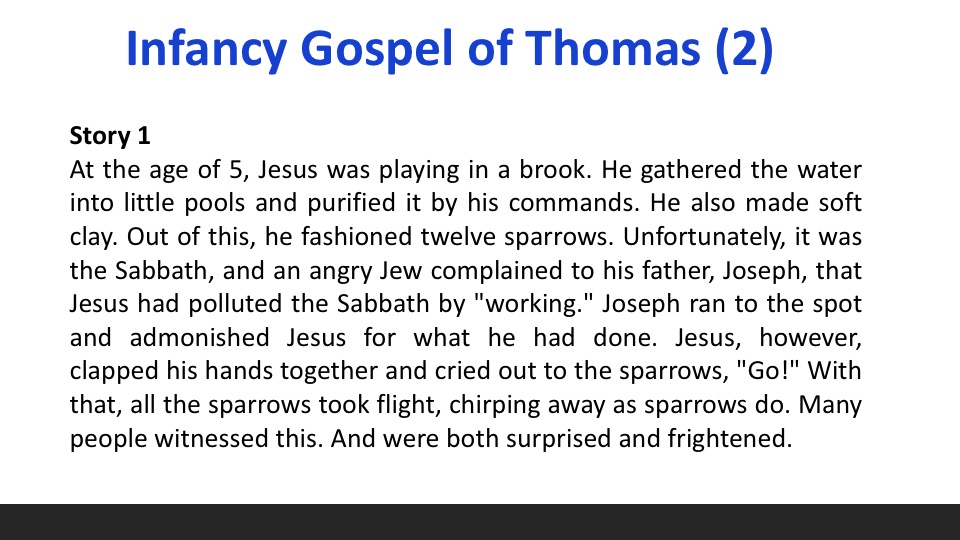
Infancy Gospel of Thomas (2)
At the age of 5, Jesus was playing in a brook. He gathered the water into little pools and purified it by his commands. He also made soft clay. Out of this, he fashioned twelve sparrows. Unfortunately, it was the Sabbath, and an angry Jew complained to his father, Joseph, that Jesus had polluted the Sabbath by "working." Joseph ran to the spot and admonished Jesus for what he had done. Jesus, however, clapped his hands together and cried out to the sparrows, "Go!" With that, all the sparrows took flight, chirping away as sparrows do. Many people witnessed this. And were both surprised and frightened.
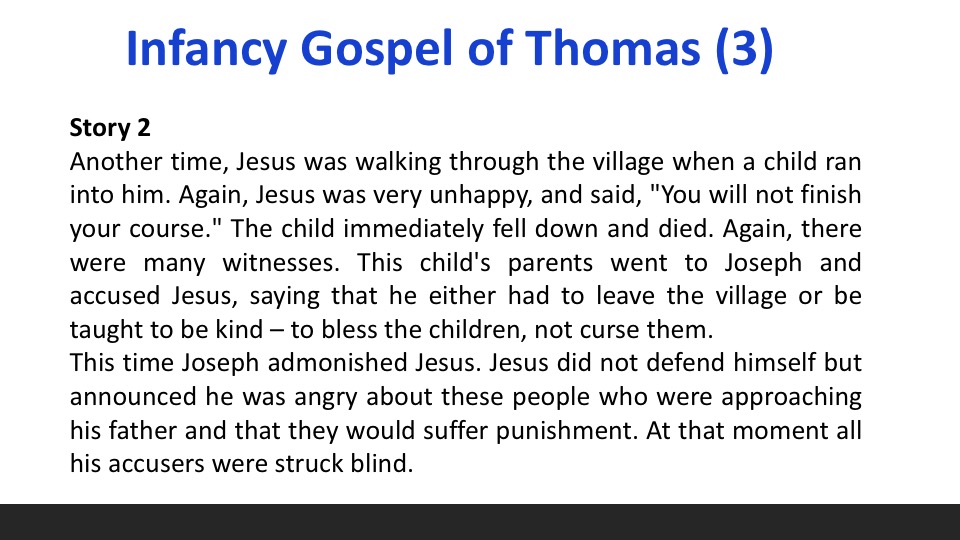
Infancy Gospel of Thomas (3)
Another time, Jesus was walking through the village when a child ran into him. Again, Jesus was very unhappy, and said, "You will not finish your course." The child immediately fell down and died. Again, there were many witnesses. This child's parents went to Joseph and accused Jesus, saying that he either had to leave the village or be taught to be kind – to bless the children, not curse them.
This time Joseph admonished Jesus. Jesus did not defend himself but announced he was angry about these people who were approaching his father and that they would suffer punishment. At that moment all his accusers were struck blind.
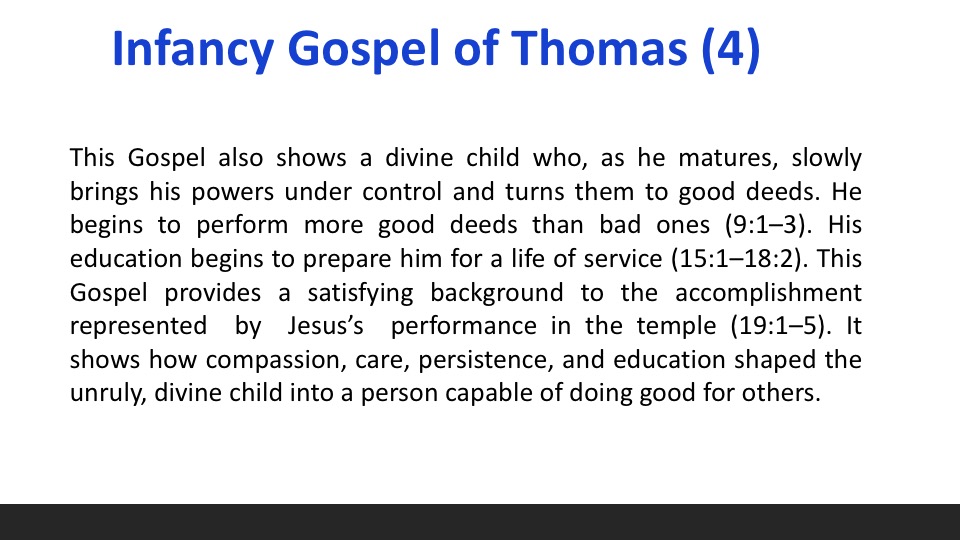
Infancy Gospel of Thomas (4)
This Gospel also shows a divine child who, as he matures, slowly brings his powers under control and turns them to good deeds. He begins to perform more good deeds than bad ones (9:1–3). His education begins to prepare him for a life of service (15:1–18:2). This Gospel provides a satisfying background to the accomplishment represented by Jesus’s performance in the temple (19:1–5). It shows how compassion, care, persistence, and education shaped the unruly, divine child into a person capable of doing good for others.
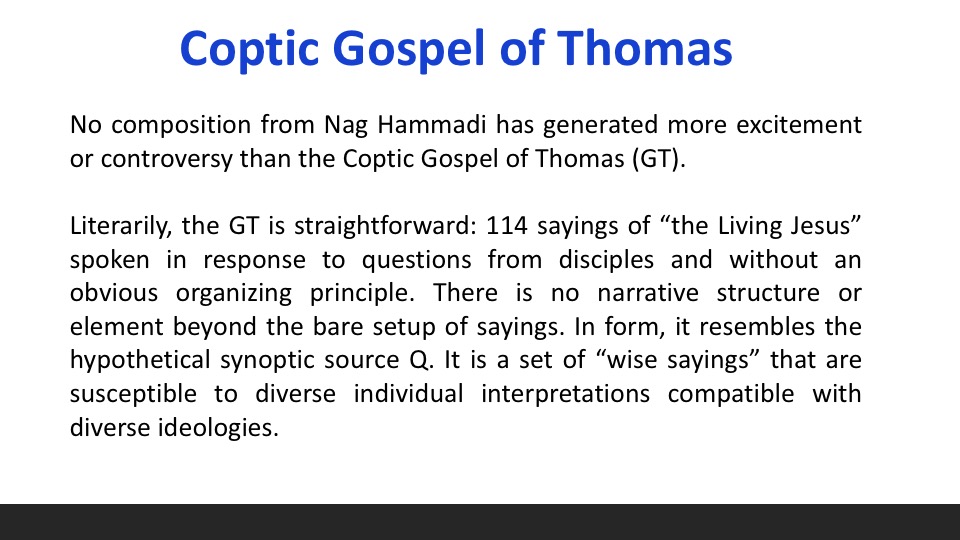
Coptic Gospel of Thomas
No composition from Nag Hammadi has generated more excitement or controversy than the Coptic Gospel of Thomas (GT).
Literarily, the GT is straightforward: 114 sayings of “the Living Jesus” spoken in response to questions from disciples and without an obvious organizing principle. There is no narrative structure or element beyond the bare setup of sayings. In form, it resembles the hypothetical synoptic source Q. It is a set of “wise sayings” that are susceptible to diverse individual interpretations compatible with diverse ideologies.
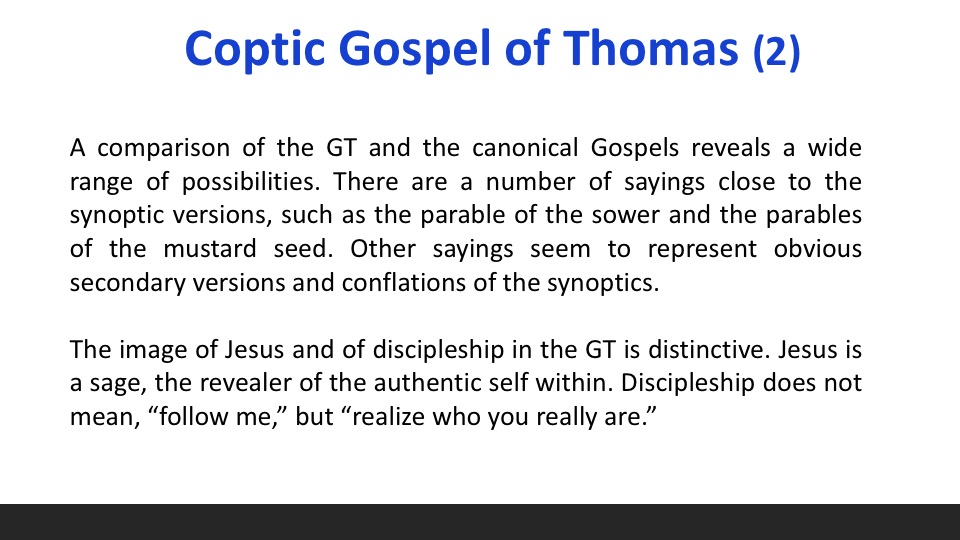
Coptic Gospel of Thomas (2)
A comparison of the GT and the canonical Gospels reveals a wide range of possibilities. There are a number of sayings close to the synoptic versions, such as the parable of the sower and the parables of the mustard seed. Other sayings seem to represent obvious secondary versions and conflations of the synoptics, such as the owners of the field. Some sayings resemble those in the synoptics but are put to quite different use. Other sayings have a stronger similarity to John’s Gospel.
The image of Jesus and of discipleship in the GT is distinctive. Jesus is a sage, the revealer of the authentic self within. Discipleship does not mean, “follow me,” but “realize who you really are.”
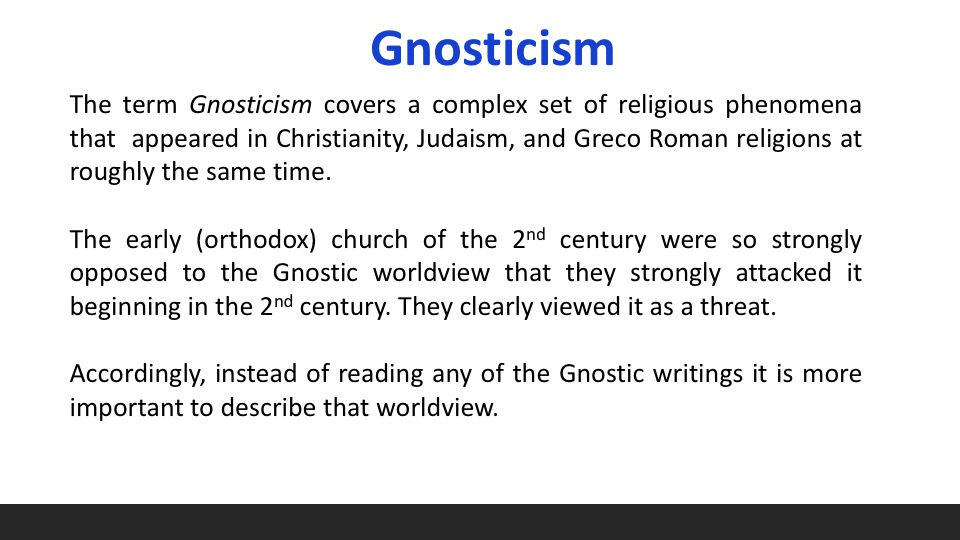
Gnosticism
The term Gnosticism covers such a complex set of religious phenomena that appeared in Christianity, Judaism, and Greco Roman religions at roughly the same time.
The early (orthodox) church of the 2ndcentury were so strongly opposed to the Gnostic worldview that they strongly attacked it beginning in the 2ndcentury. They clearly viewed it as a threat.
Accordingly, instead of reading any of the Gnostic writings it is more useful to describe that worldview.
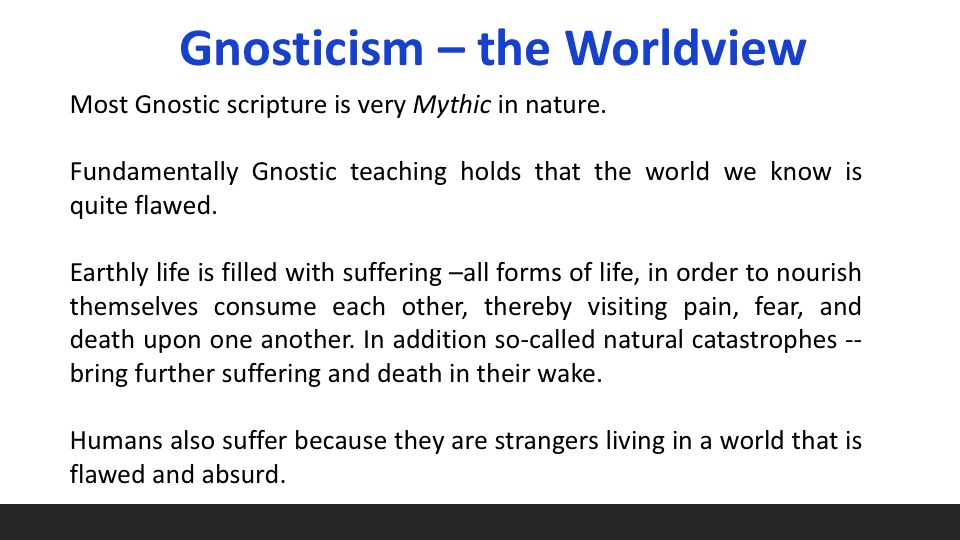
Gnosticism – the Worldview
Most Gnostic scripture is Mythic in nature rather than narrative or historical. In the summary we present below we will try to reduce that mythic language to prose .
The World Fundamentally Gnostic teaching holds that the world we know is quite flawed. Gnosticism begins with a fundamental recognition that earthly life is filled with suffering – because all forms of life, in order to nourish themselves all forms of life consume each other, thereby visiting pain, fear, and death upon one another. In addition so-called natural catastrophes -- earthquakes, floods, fires, drought, volcanic eruptions -- bring further suffering and death in their wake. Humans also suffer from the frequent recognition that they are strangers living in a world that is flawed and absurd.
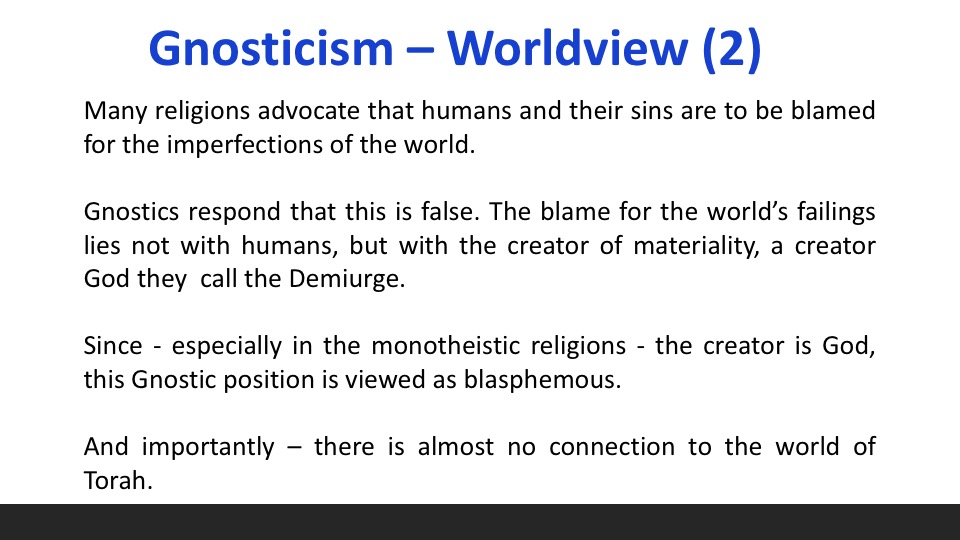
Gnosticism –Worldview (2)
Many religions advocate that humans and their sins are to be blamed for the imperfections of the world.
Gnostics respond that this is false. The blame for the world’s failings lies not with humans, but with the creator of material, a creator God they call the Demiurge.
Since - especially in the monotheistic religions - the creator is God, this Gnostic position is viewed as blasphemous.
And importantly – there is almost no connection to the world of Torah.
Gnosticism –Worldview (3)
The Deity
The Gnostic God concept is more subtle than that of most religions. In its way, it unites and reconciles Monotheism and Polytheism, as well as of Theism, Deism and Pantheism.
In the Gnostic view, there is a true, ultimate and transcendent God, who is beyond all created universes and who never created anything.
While the true God did not create anything, it emanated or brought forth from itself the substance of all there is in all the worlds, visible and invisible.
Gnosticism –Worldview (4)
The Aeons
The basic Gnostic myth has many variations, but all of these refer to Aeons, intermediate beings who exist between the ultimate, True God and ourselves. They, together with the True God, comprise the realm of Fullness (Pleroma) wherein the potency of divinity operates fully. The Fullness stands in contrast to our existential state, which in comparison may be called emptiness.
In one of the variations of the Gnostic Myth one of the Aeons (Sophia) ventured too far from the True God and emanated from her own being a flawed consciousness, a being who created a flawed material and psychic cosmos. This being, unaware of his origins, imagined himself to be the ultimate God and created the world.
Gnosticism –Worldview (5)
Salvation
In Gnostic understanding our problem is that we must be saved. But not from our sin, but from our ignorance of our true being. And our true being is spirit that is not enslaved in bodies in the material world. We are trapped in materiality, and do not belong here.
This salvation can only come from Gnosis (knowledge) – a secret knowledge.
And in Gnostic thinking that secret knowledge can only be imparted by the Messengers of Light. And for most Gnostics the principle Messenger of Light is Jesus. And Jesus came from the true god.
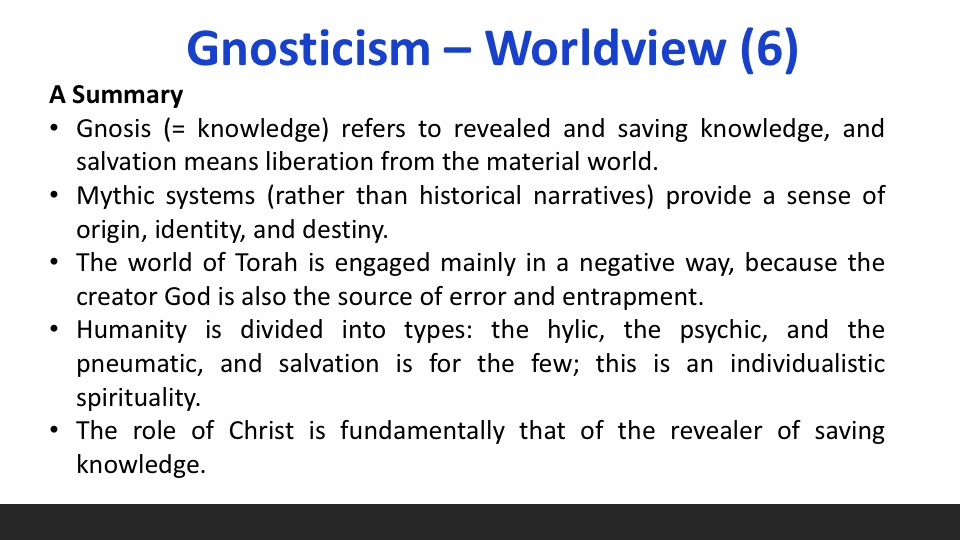
Summary - Gnosticism
• Gnosis (= knowledge) refers to revealed and saving knowledge, and salvation means liberation from the material world.
• Mythic systems (rather than historical narratives) provide a sense of origin, identity, and destiny.
• The world of Torah is engaged mainly in a negative way, because the creator God is also the source of error and entrapment.
• Humanity is divided into types: the hylic, the psychic, and the pneumatic, and salvation is for the few; this is an individualistic spirituality.
• The role of Christ is fundamentally that of the reveler of saving knowledge.
The Gnostic Gospel of Truth
• One of the most impressive literary compositions in the Nag Hammadi collection is The Gospel of Truth, possibly written by the 2nd-century Gnostic leader, Valentinus. It is neither a narrative, nor a sayings, nor a revelational Gospel but a profound reflection on the significance of Jesus.
• The Gospel places humans in a cosmic myth of being lost in materiality and recovery. The opening of the Gospel states the basic theme - The fall of humans is a matter of ignorance and forgetfulness. Ignorance is connected to the creation of matter. The human condition in materiality is one of oblivion and forgetfulness. Such alienation results in envy, strife, and division.
• There is no connection with the world of Torah.
Next Week – Open Forum